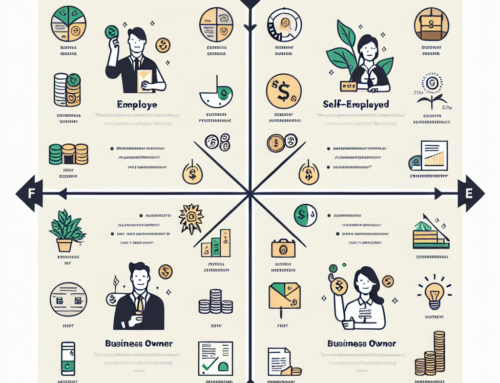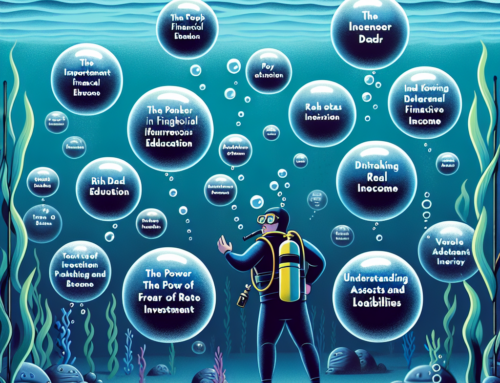
Understanding Assets And Liabilities: Key Takeaways From Rich Dad Poor Dad
”Rich Dad Poor Dad,” authored by Robert Kiyosaki, has become a seminal work in the realm of personal finance and entrepreneurship. One of the book’s most pivotal lessons revolves around understanding the difference between assets and liabilities. This distinction is crucial for entrepreneurs who aim to build sustainable wealth and achieve financial independence. By delving into the key takeaways from Kiyosaki’s insights, we can better appreciate how these concepts can be applied to entrepreneurial ventures.
To begin with, Kiyosaki introduces the contrasting financial philosophies of his ”Rich Dad” and ”Poor Dad.” His biological father, the ”Poor Dad,” was highly educated and worked diligently but struggled financially. In contrast, his ”Rich Dad,” a friend’s father, had a modest education but became wealthy through savvy investments and business acumen. This dichotomy sets the stage for understanding how different approaches to assets and liabilities can lead to vastly different financial outcomes.
One of the fundamental lessons from ”Rich Dad Poor Dad” is the definition of assets and liabilities. Kiyosaki emphasizes that assets are things that put money in your pocket, while liabilities are things that take money out of your pocket. This straightforward yet profound distinction is often overlooked by many. For entrepreneurs, recognizing this difference is essential for making informed financial decisions. For instance, purchasing a rental property that generates positive cash flow is considered an asset, whereas buying a luxury car that requires ongoing expenses is a liability.
Moreover, Kiyosaki underscores the importance of acquiring income-generating assets. Entrepreneurs should focus on building a portfolio of assets that can provide passive income streams. This could include investments in real estate, stocks, bonds, or even intellectual property such as patents and trademarks. By diversifying their asset base, entrepreneurs can create multiple revenue streams, thereby reducing financial risk and increasing stability.
Transitioning from theory to practice, Kiyosaki advises entrepreneurs to continually educate themselves about financial literacy. Understanding how to read financial statements, balance sheets, and cash flow statements is crucial. This knowledge enables entrepreneurs to make data-driven decisions and avoid common pitfalls. For example, an entrepreneur who can accurately assess the financial health of their business is better equipped to identify opportunities for growth and areas that require cost-cutting measures.
Furthermore, Kiyosaki highlights the significance of mindset in financial success. He argues that adopting a mindset focused on wealth-building and financial independence is vital. Entrepreneurs should cultivate a habit of thinking like investors, always on the lookout for opportunities to acquire assets and minimize liabilities. This proactive approach can lead to innovative business strategies and long-term financial success.
In addition to mindset, Kiyosaki stresses the value of mentorship and learning from others. Entrepreneurs can benefit immensely from seeking advice and guidance from those who have successfully navigated the financial landscape. By learning from the experiences of seasoned investors and business owners, entrepreneurs can avoid common mistakes and accelerate their path to financial independence.
In conclusion, ”Rich Dad Poor Dad” offers invaluable lessons on understanding assets and liabilities, which are particularly relevant for entrepreneurs. By distinguishing between income-generating assets and expense-inducing liabilities, focusing on financial education, adopting a wealth-building mindset, and seeking mentorship, entrepreneurs can build a solid foundation for financial success. These principles, when applied diligently, can transform the way entrepreneurs manage their finances and ultimately lead to a more prosperous and secure future.
The Importance Of Financial Education For Entrepreneurs
”Rich Dad Poor Dad” by Robert Kiyosaki is a seminal work that has influenced countless entrepreneurs and investors around the world. One of the core messages of the book is the importance of financial education, a lesson that is particularly crucial for entrepreneurs. Financial education is not just about understanding numbers; it’s about comprehending how money works, how to make it work for you, and how to leverage it to build wealth. For entrepreneurs, this knowledge can be the difference between success and failure.
To begin with, financial education equips entrepreneurs with the tools to make informed decisions. When you understand financial statements, cash flow, and the principles of investing, you are better positioned to evaluate opportunities and risks. This knowledge allows you to create realistic business plans, set achievable financial goals, and develop strategies to reach them. Without a solid financial foundation, even the most innovative business ideas can falter.
Moreover, financial education helps entrepreneurs manage their resources more effectively. In the early stages of a business, resources are often limited, and every dollar counts. Understanding how to budget, forecast, and allocate funds can help you stretch your resources further and avoid unnecessary expenses. This is where Kiyosaki’s lessons on assets and liabilities come into play. By focusing on acquiring assets that generate income, rather than liabilities that drain resources, entrepreneurs can build a more sustainable business model.
In addition, financial education fosters a mindset of continuous learning and adaptability. The business world is dynamic, and market conditions can change rapidly. Entrepreneurs who are financially literate are better prepared to adapt to these changes. They can pivot their strategies, explore new revenue streams, and make adjustments to their business models as needed. This adaptability is a key factor in long-term success.
Furthermore, financial education can also enhance an entrepreneur’s ability to attract investors and secure funding. Investors are more likely to support a business that demonstrates a clear understanding of financial principles and a solid plan for profitability. When you can articulate your financial strategy and show how you plan to generate returns, you build credibility and trust with potential investors. This can open doors to funding opportunities that might otherwise be out of reach.
Another important aspect highlighted in ”Rich Dad Poor Dad” is the concept of financial independence. For entrepreneurs, this means creating a business that not only survives but thrives without constant oversight. Financial education teaches you how to build systems and processes that generate passive income, allowing you to focus on growth and innovation rather than day-to-day operations. This shift from working in your business to working on your business is a critical step towards achieving financial independence.
Lastly, financial education empowers entrepreneurs to take calculated risks. Every business venture involves some level of risk, but understanding the financial implications of your decisions can help you mitigate those risks. By analyzing potential outcomes and preparing for various scenarios, you can make more confident and informed choices. This proactive approach can lead to more successful ventures and a higher likelihood of achieving your entrepreneurial goals.
In conclusion, the importance of financial education for entrepreneurs cannot be overstated. It provides the foundation for making informed decisions, managing resources effectively, adapting to changes, attracting investors, achieving financial independence, and taking calculated risks. By embracing the lessons from ”Rich Dad Poor Dad,” entrepreneurs can build a solid financial foundation that supports long-term success and growth.
How To Build Wealth Through Real Estate Investments
”Rich Dad Poor Dad” by Robert Kiyosaki has become a cornerstone for many aspiring entrepreneurs seeking financial independence. One of the most compelling aspects of the book is its emphasis on real estate as a vehicle for building wealth. For those looking to delve into real estate investments, the lessons from ”Rich Dad Poor Dad” offer invaluable insights that can guide you on your journey to financial success.
To begin with, Kiyosaki underscores the importance of financial education. He argues that understanding the basics of real estate, such as market trends, property valuation, and financing options, is crucial. This foundational knowledge allows you to make informed decisions and avoid common pitfalls. For instance, knowing how to evaluate a property’s potential for appreciation and rental income can help you identify lucrative opportunities. Additionally, understanding the tax benefits associated with real estate investments can significantly enhance your returns.
Transitioning from theory to practice, Kiyosaki emphasizes the importance of starting small. He suggests that new investors begin with single-family homes or small multi-family properties. These types of investments are generally less risky and easier to manage, providing a solid foundation for future, more complex ventures. By starting small, you can gain hands-on experience and gradually build your confidence and expertise.
Moreover, Kiyosaki highlights the power of leverage in real estate investments. Leverage allows you to use borrowed capital to increase the potential return on investment. For example, by securing a mortgage, you can purchase a property with a relatively small down payment, thereby amplifying your buying power. However, it’s essential to use leverage wisely. Over-leveraging can lead to financial strain, especially if the property doesn’t generate the expected income. Therefore, it’s crucial to conduct thorough due diligence and ensure that the property’s cash flow can comfortably cover the mortgage payments and other expenses.
Another key lesson from ”Rich Dad Poor Dad” is the importance of cash flow. Kiyosaki advises focusing on properties that generate positive cash flow, meaning the rental income exceeds the expenses. Positive cash flow not only provides a steady income stream but also offers a cushion during economic downturns. To achieve this, it’s essential to carefully analyze the property’s income potential and operating costs. This includes considering factors such as location, property condition, and market demand.
In addition to cash flow, Kiyosaki stresses the significance of long-term appreciation. While cash flow provides immediate financial benefits, appreciation can lead to substantial wealth accumulation over time. By investing in properties in high-growth areas, you can benefit from both rental income and property value appreciation. However, predicting appreciation requires a keen understanding of market trends and economic indicators. Therefore, staying informed and continuously educating yourself is vital.
Furthermore, Kiyosaki encourages investors to adopt a proactive approach to property management. Effective property management can enhance the property’s value and ensure a steady income stream. This involves maintaining the property, addressing tenant concerns promptly, and implementing strategies to maximize occupancy rates. While some investors prefer to manage properties themselves, others opt to hire professional property management services. Regardless of the approach, the goal is to ensure the property remains a profitable and sustainable investment.
In conclusion, ”Rich Dad Poor Dad” offers a wealth of knowledge for entrepreneurs looking to build wealth through real estate investments. By focusing on financial education, starting small, leveraging wisely, prioritizing cash flow, and adopting a proactive management approach, you can navigate the complexities of real estate investing and achieve long-term financial success. As Kiyosaki aptly puts it, the journey to financial independence begins with a single step, and with the right knowledge and mindset, you can turn real estate into a powerful wealth-building tool.
The Power Of Passive Income: Lessons From Rich Dad Poor Dad
”Rich Dad Poor Dad,” authored by Robert Kiyosaki, has become a seminal work in the realm of personal finance and entrepreneurship. One of the most compelling lessons from the book is the power of passive income, a concept that can significantly alter the financial trajectory of entrepreneurs. Understanding and leveraging passive income can be a game-changer, and Kiyosaki’s insights provide a roadmap for those eager to break free from the traditional paycheck-to-paycheck cycle.
In ”Rich Dad Poor Dad,” Kiyosaki contrasts the financial philosophies of his two father figures: his biological father, whom he refers to as ”Poor Dad,” and his best friend’s father, the ”Rich Dad.” While Poor Dad emphasized the importance of a stable job and working hard for money, Rich Dad advocated for making money work for you. This fundamental difference in mindset is crucial for entrepreneurs who aspire to build sustainable wealth.
One of the key takeaways from Rich Dad’s teachings is the importance of acquiring assets that generate passive income. Unlike earned income, which requires continuous effort and time, passive income flows in with minimal ongoing work. This can come from various sources such as rental properties, dividends from investments, royalties from intellectual property, or even businesses that operate independently of the owner’s direct involvement. For entrepreneurs, this means creating systems and investing in opportunities that yield returns without constant oversight.
Transitioning from active to passive income requires a shift in perspective. Entrepreneurs often start by investing their time and energy into building a business. However, to truly harness the power of passive income, they must eventually focus on creating systems that allow the business to run smoothly without their constant presence. This might involve hiring competent managers, automating processes, or developing scalable products and services. By doing so, entrepreneurs can free up their time to explore new ventures or simply enjoy the fruits of their labor.
Moreover, Kiyosaki emphasizes the importance of financial education in achieving passive income. Many people are trapped in the rat race because they lack the knowledge to make informed investment decisions. Entrepreneurs should continuously educate themselves about different asset classes, market trends, and investment strategies. This knowledge not only helps in identifying lucrative opportunities but also in mitigating risks associated with investments.
Another lesson from ”Rich Dad Poor Dad” is the significance of leveraging other people’s money (OPM) to build wealth. Rich Dad taught Kiyosaki that debt, when used wisely, can be a powerful tool for acquiring income-generating assets. For instance, taking a mortgage to buy rental properties can provide a steady stream of rental income while the property’s value appreciates over time. Entrepreneurs can apply this principle by seeking investors or loans to fund business expansions, thereby increasing their potential for passive income.
Furthermore, Kiyosaki’s book underscores the importance of a long-term perspective. Building passive income streams is not an overnight endeavor; it requires patience, persistence, and strategic planning. Entrepreneurs should set clear financial goals and develop a roadmap to achieve them. This might involve reinvesting profits, diversifying income sources, and continuously optimizing their business operations.
In conclusion, ”Rich Dad Poor Dad” offers invaluable lessons on the power of passive income, particularly for entrepreneurs. By shifting their focus from earning a paycheck to building income-generating assets, continuously educating themselves, leveraging other people’s money, and maintaining a long-term perspective, entrepreneurs can create a sustainable financial future. Kiyosaki’s insights serve as a guiding light for those willing to embrace the mindset of making money work for them, ultimately leading to financial freedom and success.
Developing An Entrepreneurial Mindset: Insights From Robert Kiyosaki
”Rich Dad Poor Dad” by Robert Kiyosaki is a seminal work that has inspired countless individuals to rethink their approach to money, investing, and entrepreneurship. At its core, the book contrasts the financial philosophies of Kiyosaki’s ”rich dad” and ”poor dad,” offering valuable lessons for anyone looking to develop an entrepreneurial mindset. By delving into these insights, entrepreneurs can gain a deeper understanding of how to navigate the complex world of investments and build sustainable wealth.
One of the most compelling lessons from ”Rich Dad Poor Dad” is the importance of financial education. Kiyosaki emphasizes that traditional schooling often fails to teach students about money management, leaving them ill-prepared for real-world financial challenges. Instead, he advocates for self-education and continuous learning. Entrepreneurs, in particular, must be proactive in seeking out knowledge about investments, market trends, and financial strategies. This commitment to learning can provide a competitive edge and enable more informed decision-making.
Transitioning from the concept of financial education, Kiyosaki introduces the idea of assets versus liabilities. He explains that the rich focus on acquiring assets—things that put money in their pockets—while the poor and middle class often accumulate liabilities, which take money out of their pockets. For entrepreneurs, this distinction is crucial. Investing in assets such as real estate, stocks, or a business can generate passive income and build long-term wealth. Conversely, overextending on liabilities like expensive cars or high-interest loans can hinder financial growth. By prioritizing asset acquisition, entrepreneurs can create a more stable financial foundation.
Another key insight from Kiyosaki’s work is the concept of risk management. Many people shy away from investments due to the perceived risks involved. However, Kiyosaki argues that understanding and managing risk is a fundamental part of entrepreneurship. He suggests that rather than avoiding risk altogether, entrepreneurs should focus on mitigating it through thorough research, diversification, and strategic planning. This approach allows for calculated risks that can lead to significant rewards, rather than reckless gambles that could result in financial ruin.
In addition to risk management, Kiyosaki highlights the importance of leveraging other people’s money (OPM). He explains that the rich often use OPM to finance their investments, thereby minimizing their own financial exposure while maximizing potential returns. For entrepreneurs, this could mean seeking out investors, securing loans, or forming strategic partnerships. By effectively leveraging OPM, entrepreneurs can scale their businesses more rapidly and take advantage of opportunities that would otherwise be out of reach.
Furthermore, Kiyosaki underscores the value of building a strong network. He believes that relationships are a form of currency and that surrounding oneself with like-minded, successful individuals can open doors to new opportunities. Entrepreneurs should actively seek out mentors, join professional organizations, and attend industry events to expand their networks. These connections can provide invaluable advice, support, and resources that can propel their ventures forward.
Lastly, Kiyosaki’s emphasis on mindset cannot be overstated. He advocates for a shift from a scarcity mindset to an abundance mindset. Entrepreneurs should view challenges as opportunities for growth and remain resilient in the face of setbacks. This positive outlook can foster innovation, drive, and perseverance, all of which are essential qualities for entrepreneurial success.
In conclusion, ”Rich Dad Poor Dad” offers a wealth of insights for developing an entrepreneurial mindset. By focusing on financial education, distinguishing between assets and liabilities, managing risk, leveraging other people’s money, building a strong network, and adopting an abundance mindset, entrepreneurs can navigate the complexities of investments and build sustainable wealth. These lessons from Robert Kiyosaki’s work provide a roadmap for anyone looking to achieve financial independence and entrepreneurial success.
We have lots of exciting coming events in Entrepreneurship, Investing and Personal Development. You can find them all here:
www.swedishwealthinstitute.se/events




